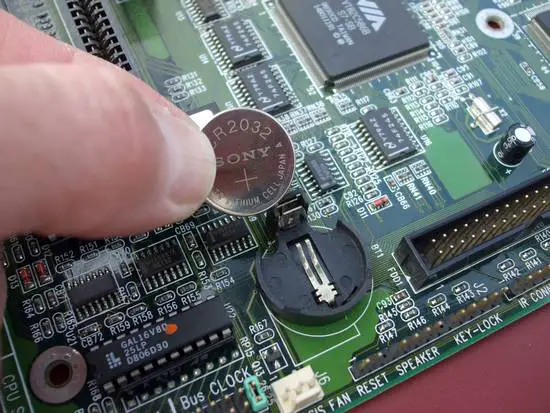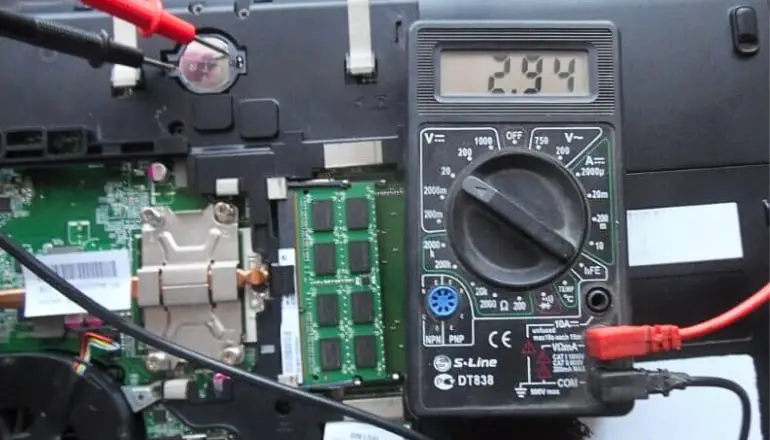4 Types of CMOS Battery (Lithium, Alkaline, NiCd, NiMH).
CMOS (Complementary Metal Oxide Semiconductor) refers to certain transistor circuits prebuilt on motherboard around PCIe slots. CMOS memory stores important system information, such as the date and time, disk parameters, and memory settings. CMOS is also referred to as Real Time Clock (RTC) or Non-Volatile RAM (NVRAM) and is powered by a CMOS battery.
There are different types of CMOS batteries.
- Lithium batteries
- Alkaline
- Nickel cadmium (NiCd)
- Nickel metal hydride (NiMH)
4 Types of CMOS Battery
These tiny CMOS batteries are typically used in laptops, motherboards and PCBs of embedded systems. The primary purpose of the CMOS battery is to maintain the BIOS settings even when the system is turned off or unplugged from a power source. Without a CMOS battery, changes made to the BIOS settings would be lost when it loses power.
Let’s know the CMOS battery type one by one.
1. Lithium batteries
Flat lithium batteries are button-type batteries – the most used today to power the CMOS due to their long life. They can last up to five years. These batteries are made of lithium manganese dioxide and resemble watch batteries.
In total, three types of lithium batteries can be distinguished by thickness:
- CR2032
- CR2016
- CR2025

Differences are capacity and thickness, mentioned in the table below.
Lithium Bbattery Type | Thickness (mm) | Capacity (mAh) | Remarks |
CR2016 | 1.6 | 90 | Commonly used in small devices |
CR2025 | 2.5 | 160 | Commonly used |
CR2032 | 3.2 | 225 | Most common today |
CR2035 | 3.5 | 280 | Less common & larger szie |
Lithium CMOS batteries are recyclable but not rechargeable. It can last from two to five years. The battery’s manufacturer does not really matter since this does not affect its operation.
The main reason for replacing the CMOS battery is a voltage drop. In a new battery, it is 3 volts, and the ideal range should be 2.75-3.3 Volts for operation. You can check this with an electronic voltmeter.

It is necessary to replace Lithium batteries without waiting for complete discharge since this will lead to system failures. For example, the PC, graphic card, and cooler will start slower. Plus, various programs may stop working. Also, the PC may start to reboot on its own, or the BIOS (Legacy or UEFi) parameters will be modified.
2. Alkaline batteries
Some computers, including Apple’s Mac, use 4.5-volt alkaline batteries to power the CMOS. Alkaline batteries are neither rechargeable nor recyclable.
These batteries are not rechargeable or recyclable. Aside from not being good for the environment, the biggest downside to using alkaline batteries is their tendency to rust faster and not last as long as lithium ones. Such batteries usually last 2-3 years.
Thus, Lithium is the better option with a long service life and a lower self-discharge rate; then Lithium is the better option.
3. Nickel cadmium batteries
Nickel Cadmium (NiCd) batteries were widely used in computers before. Although it is rechargeable and has high energy density and robustness but, their environmental impact is even worse due to the heavy metal cadmium if disposed of improperly.
NiCd batteries are known to have a “memory effect,” which means that if they are not fully discharged before recharging, their capacity can be reduced over time. In theory, NiCd batteries have a useful life of about 3 to 5 years, but unfortunately, overcharging reduced this time. Due to these drawbacks, they are less common and have been replaced by newer battery types.
4. Nickel metal hydride batteries
Nickel metal hydride (NiMh) batteries are rechargeable and have advantages over NiCd batteries. They hold 40% more charge and have a longer lifespan on a single charge. Unlike NiCd batteries, NiMH batteries do not need to be fully discharged before charging. NiMH batteries can also be stored for longer periods, although recharging them every 6 months is recommended.
While NiCd batteries use toxic cadmium for their negative electrodes, NiMh batteries use an alloy that absorbs hydrogen, which is more suitable for the environment than NiCd. NiMH batteries typically last between 1.5 to 3 years of 3.6-volt power of CMOS have been used in various applications such as portable electronics, power tools, etc.
Final Thoughts
Among the above, lithium batteries are the most common type for more modern systems and have a longer lifespan than alkaline batteries. On the other hand, NiMh batteries are suited for older systems that require a 3.6-volt output.
Regardless of the type of battery chosen, it is recommended to always keep spares on hand in case of an emergency or power outage.
When CMOS batteries become weak or start to fail, the stored information can be lost, and important configuration settings may need to be reset.
This is why it’s essential to periodically check your system for issues related to CMOS battery failure. Fortunately, replacing a CMOS battery is relatively uncomplicated.
